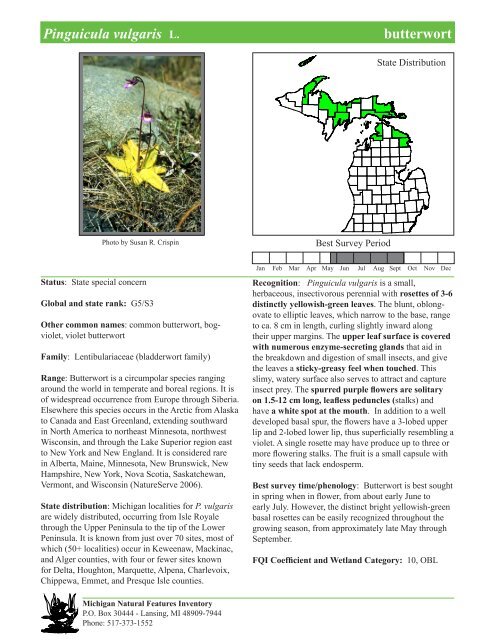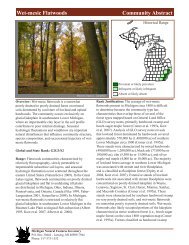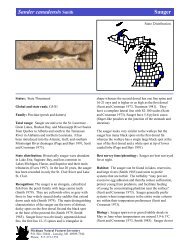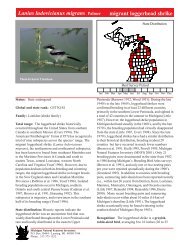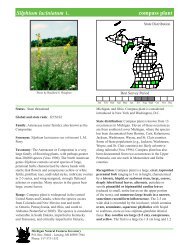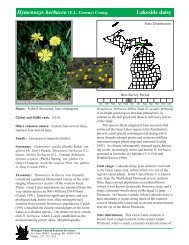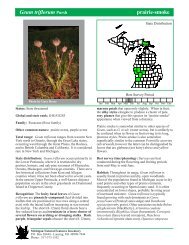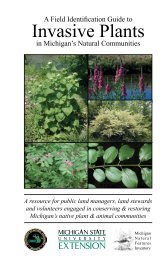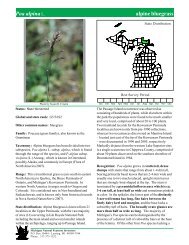Pinguicula vulgaris - Michigan Natural Features Inventory - Michigan ...
Pinguicula vulgaris - Michigan Natural Features Inventory - Michigan ...
Pinguicula vulgaris - Michigan Natural Features Inventory - Michigan ...
Create successful ePaper yourself
Turn your PDF publications into a flip-book with our unique Google optimized e-Paper software.
utterwort, Page 1<br />
<strong>Pinguicula</strong> <strong>vulgaris</strong> L. butterwort<br />
Photo by Susan R. Crispin<br />
Status: State special concern<br />
Global and state rank: G5/S3<br />
Other common names: common butterwort, bogviolet,<br />
violet butterwort<br />
Family: Lentibulariaceae (bladderwort family)<br />
Range: Butterwort is a circumpolar species ranging<br />
around the world in temperate and boreal regions. It is<br />
of widespread occurrence from Europe through Siberia.<br />
Elsewhere this species occurs in the Arctic from Alaska<br />
to Canada and East Greenland, extending southward<br />
in North America to northeast Minnesota, northwest<br />
Wisconsin, and through the Lake Superior region east<br />
to New York and New England. It is considered rare<br />
in Alberta, Maine, Minnesota, New Brunswick, New<br />
Hampshire, New York, Nova Scotia, Saskatchewan,<br />
Vermont, and Wisconsin (NatureServe 2006).<br />
State distribution: <strong>Michigan</strong> localities for P. <strong>vulgaris</strong><br />
are widely distributed, occurring from Isle Royale<br />
through the Upper Peninsula to the tip of the Lower<br />
Peninsula. It is known from just over 70 sites, most of<br />
which (50+ localities) occur in Keweenaw, Mackinac,<br />
and Alger counties, with four or fewer sites known<br />
for Delta, Houghton, Marquette, Alpena, Charlevoix,<br />
Chippewa, Emmet, and Presque Isle counties.<br />
<strong>Michigan</strong> <strong>Natural</strong> <strong>Features</strong> <strong>Inventory</strong><br />
P.O. Box 30444 - Lansing, MI 48909-7944<br />
Phone: 517-373-1552<br />
Jan<br />
Feb<br />
Mar<br />
Apr<br />
Best Survey Period<br />
May<br />
Jun<br />
Jul<br />
State Distribution<br />
Aug<br />
Sept<br />
Oct<br />
Nov<br />
Dec<br />
Recognition: <strong>Pinguicula</strong> <strong>vulgaris</strong> is a small,<br />
herbaceous, insectivorous perennial with rosettes of 3-6<br />
distinctly yellowish-green leaves. The blunt, oblongovate<br />
to elliptic leaves, which narrow to the base, range<br />
to ca. 8 cm in length, curling slightly inward along<br />
their upper margins. The upper leaf surface is covered<br />
with numerous enzyme-secreting glands that aid in<br />
the breakdown and digestion of small insects, and give<br />
the leaves a sticky-greasy feel when touched. This<br />
slimy, watery surface also serves to attract and capture<br />
insect prey. The spurred purple flowers are solitary<br />
on 1.5-12 cm long, leafless peduncles (stalks) and<br />
have a white spot at the mouth. In addition to a well<br />
developed basal spur, the flowers have a 3-lobed upper<br />
lip and 2-lobed lower lip, thus superficially resembling a<br />
violet. A single rosette may have produce up to three or<br />
more flowering stalks. The fruit is a small capsule with<br />
tiny seeds that lack endosperm.<br />
Best survey time/phenology: Butterwort is best sought<br />
in spring when in flower, from about early June to<br />
early July. However, the distinct bright yellowish-green<br />
basal rosettes can be easily recognized throughout the<br />
growing season, from approximately late May through<br />
September.<br />
FQI Coefficient and Wetland Category: 10, OBL
utterwort, Page 2<br />
Habitat: <strong>Pinguicula</strong> <strong>vulgaris</strong> is a well-known<br />
calciphile (favoring alkaline or lime-rich habitats) and<br />
as with most insectivorous plants, prefers wet substrates.<br />
It is found in moist alkaline rock crevices and outcrops;<br />
rocky or gravelly shores, sandy, interdunal shoreline<br />
flats; marshy soils near bogs, wet alvars, and the marly,<br />
calcareous soils of coastal and northern fens. It also<br />
occurs in Lake Superior coastal areas where it inhabits<br />
volcanic bedrock lakeshore areas, favoring basalts and<br />
conglomerate bedrock types. Most <strong>Michigan</strong> locations<br />
are along Great Lakes shores, particularly on rocky,<br />
wet beaches and nearshore wetlands and interdunal<br />
areas. Primula mistassinica (birds-eye primrose) is a<br />
common associate as are numerous other herbs such as<br />
Drosera rotundifolia (round-leaved sundew), D. linearis<br />
(linear-leaved sundew), Sarracenia purpurea (pitcherplant),<br />
Utricularia intermedia (flat-leaved bladderwort),<br />
U. cornuta (horned bladderwort), Castilleja coccinea<br />
(Indian paintbrush), Parnassia glauca grass-of-<br />
Parnassus), Tofieldia glutinosa (false asphodel), and<br />
Gentianopsis procera (small fringed gentian). The<br />
rare Solidago houghtonii (Houghton’s goldenrod) is<br />
an expected associate in the Straits region, as might be<br />
Empetrum nigrum (black crowberry) and other rarities<br />
such as the similarly boreal Erigeron hyssopifolius<br />
(hyssop-leaved fleabane) and Carex scirpoidea (bulrush<br />
sedge). These associates are similar to those found with<br />
butterwort in shoreline limestone pavement or wet alvar<br />
sites.<br />
In bedrock shoreline communities in the more<br />
northern portion of its <strong>Michigan</strong> range, butterwort<br />
occurs on alkaline basalts, volcanic conglomerates,<br />
and occasionally wet sandstones, where associates<br />
include such species as Campanula rotundifolia<br />
(harebell), Deschampsia cespitosa (hair grass),<br />
Festuca saximontana (fescue), Artemisia campestris<br />
(wormwood), Carex viridula (sedge), and Solidago<br />
simplex (Gillman’s goldenrod).<br />
Biology: <strong>Pinguicula</strong> <strong>vulgaris</strong> is an insectivorous,<br />
perennial herb that secretes mucilaginous fluids and<br />
digestive enzymes through two types of leaf glands.<br />
Small insects first adhere to the mucilaginous fluids<br />
secreted by the stalked ‘sticky’ glands. Their struggling<br />
movements, which stimulate increased production of<br />
the mucilaginous fluids, then cause the secretion of<br />
enzyme-containing fluids from the ‘sessile’ glands. It<br />
is the latter secretion that is primarily responsible for<br />
insect digestion and nutrient absorption by the plant.<br />
<strong>Michigan</strong> <strong>Natural</strong> <strong>Features</strong> <strong>Inventory</strong><br />
P.O. Box 30444 - Lansing, MI 48909-7944<br />
Phone: 517-373-1552<br />
Upon stimulation, the leaves also roll inward from their<br />
margins; this is thought to minimize the loss of prey and<br />
also aid in enzymatic degradation by increasing the leaf<br />
surface area in contact with the prey. This in-rolling may<br />
also reduce the loss of enzymes and nutrients through<br />
seepage or by preventing exposure to rainfall.<br />
Flowering plants can be found in late May through<br />
June and into early July, followed by the formation of<br />
a capsule containing several seeds, typically from early<br />
July through August. During winter, butterwort persists<br />
as a winter resting bud known as a hibernaculum<br />
that begins to form in the center of the rosette by late<br />
summer. This bud is entirely without roots and therefore<br />
may be dispersed by water movement, wind, or<br />
possibly animal activity. The small scale-leaves of the<br />
hibernaculum contain starches that nurture the enclosed<br />
seedling during spring emergence when new leaves and<br />
roots are forming.<br />
Biologists have long been interested in carnivorous<br />
plants, particularly with regard to the topics of<br />
resource allocation, reproduction, plant demography<br />
(the structure and dynamics of populations), and the<br />
evolution of carnivory as an adaptation to low nutrient<br />
availability. Owing to the extensive nature of this<br />
literature, which cannot be adequately summarized<br />
here, the reader is referred to the following references<br />
for further information on these topics: Méndez and<br />
Karlsson (2005), Méndez and Karlsson (2004), Eckstein<br />
and Karlsson (2001), Worley and Harder (1999), Thorén<br />
and Karlsson (1998), Thorén et al. (1996), Lesica and<br />
Steele (1996), Worley and Harder (1996), Svensson<br />
et al. (1993), Kull and Zobel (1991), Karlsson et al.<br />
(1990), Karlsson 1988), Karlsson and Carlsson (1984),<br />
and Aldenius et al. (1983).<br />
Conservation/management: Several large butterwort<br />
populations are protected on public lands, including<br />
several sites within Isle Royale National Park, and also<br />
via a number of private nature preserves, including<br />
large exemplary areas managed by the <strong>Michigan</strong> Nature<br />
Conservancy in the Straits region. Habitat loss through<br />
shoreline development and recreation is the most<br />
critical threat to butterwort populations, and as for many<br />
coastal areas, the prevalence and widespread use of<br />
off-road-vehicles (ORVs) remains a constant and ever<br />
present threat to sites. Conservation strategies should<br />
focus on the identification and preservation of shoreline<br />
ecosystems that encompass known and potential
habitat. Equally important is the education of private<br />
landowners as well as federal, state, and local land<br />
managers to provide guidance on how to identify and<br />
steward important coastal systems and their associated<br />
rare species.<br />
Comments: The word <strong>Pinguicula</strong> is derived from the<br />
Latin word pinguis, meaning ‘fat’, and refers to the<br />
leaves being ‘greasy’ or ‘buttery’ to the touch. It is<br />
reported that the leaves were once used by farmers to<br />
coagulate milk.<br />
Research needs: The principal need at present, given<br />
the extensive research that has been conducted to<br />
date, is perhaps the identification of viable colonies<br />
and conducting monitoring to determine population<br />
dynamics, trends, changes in status, and the presence of<br />
natural and artificial threats.<br />
Related abstracts: Coastal fen, northern fen, interdunal<br />
wetland, sand and gravel shore, limestone bedrock<br />
lakeshore, limestone cobble shore, volcanic bedrock<br />
lakeshore, cherrystone drop, Eastern massasauga, Hine’s<br />
emerald, incurvate emerald, crested vertigo, six-whorl<br />
vertigo, tapered vertigo, alpine bluegrass, calypso,<br />
English sundew, Franklin’s Phacelia, Hill’s thistle,<br />
Houghton’s goldenrod, prairie Indian plantain, ram’s<br />
head orchid, Richardson’s sedge, rock whitlow-grass,<br />
and numerous additional animal and plant species.<br />
Selected references:<br />
Aldenius, J., B. Carlsson, and S. Karlsson. 1983.<br />
Effects of insect trapping on growth and nutrient<br />
content of <strong>Pinguicula</strong> <strong>vulgaris</strong> L. in relation to the<br />
nutrient content of the substrate. New Phytologist<br />
93: 53-59.<br />
Eckstein, R.L. and P.S. Karlsson. 2001. The effect of<br />
reproduction on nitrogen use-efficiency of three<br />
species of the carnivorous genus <strong>Pinguicula</strong>. J.<br />
Ecol. 89: 798-806.<br />
Heide, Fr. 1912. Medd. Om Gronland. 36:441-47.<br />
Kull, K. and M. Zobel. 1991. High species richness in<br />
an Estonian wooded meadow. J. Veg. Sci. 2: 715-<br />
718.<br />
Karlsson, P.S., B.M. Svensson, B.Ǻ, and K.O. Nordell.<br />
1990. Resource investment in reproduction and its<br />
<strong>Michigan</strong> <strong>Natural</strong> <strong>Features</strong> <strong>Inventory</strong><br />
P.O. Box 30444 - Lansing, MI 48909-7944<br />
Phone: 517-373-1552<br />
butterwort, Page 3<br />
consequences in three <strong>Pinguicula</strong> species. Oikos<br />
59: 393-398.<br />
Karlsson, P.S. 1988. Seasonal patterns of nitrogen,<br />
phosphorous and potassium utilization by three<br />
<strong>Pinguicula</strong> species. Functional Ecology 2: 203-209.<br />
Karlsson, P.S. and B. Carlsson. 1984. Why does<br />
<strong>Pinguicula</strong> <strong>vulgaris</strong> L. trap insects? New<br />
Phytologist. 97: 25-30.<br />
Lesica, P. and B.M. Steele. 1996. A method for<br />
monitoring long-term population trends: an<br />
example using rare arctic-alpine plants. Ecological<br />
Applications 6: 879-887.<br />
Lloyd, Francis E. 1942. The Carnivorous Plants.<br />
Chronica Botanica, Waltham.<br />
Méndez, M. and P.S. Karlsson. 2005. Nutrient<br />
stoichiometry in <strong>Pinguicula</strong> <strong>vulgaris</strong>: nutrient<br />
availability, plant size, and reproductive status.<br />
Ecology 86: 982-991.<br />
Méndez, M. and P.S. Karlsson. 2004. Betweenpopulation<br />
variation in size-dependent reproduction<br />
and reproductive allocation in <strong>Pinguicula</strong> <strong>vulgaris</strong><br />
(Lentibulariaceae) and its environmental correlates.<br />
Oikos 104: 59-70.<br />
Méndez, M., D.G. Jones, and Y. Manetas. 1999.<br />
Enhanced UV-B radiation under field conditions<br />
increases anthocyanin and reduces the risk of<br />
photoinhibition but does not affect growth in<br />
the carnivorous plant <strong>Pinguicula</strong> <strong>vulgaris</strong>. New<br />
Phytologist 144: 275-282.<br />
NatureServe. 2006. NatureServe Explorer: an online<br />
encyclopedia of life [web application]. Version<br />
6.1. NatureServe, Arlington, Virginia. Available<br />
http://www.natureserve.org/explorer. (Accessed:<br />
December 15, 2006).<br />
Slack, A. 1979. The Carnivorous Plants. MIT Press,<br />
Cambridge, MA<br />
Thorén, L.M. and P.S. Karlsson. 1998. Effects of<br />
supplementary feeding on growth and reproduction<br />
of three carnivorous plant species in a subarctic<br />
environment. Journal of Ecology 86: 501-510.
utterwort, Page 4<br />
Thorén, L.M., P.S. Karlsson, and J. Tuomi. 1996.<br />
Somatic cost of reproduction in three carnivorous<br />
<strong>Pinguicula</strong> species. Oikos 76: 427-434.<br />
Svensson, B.M., B.Ǻ. Carlsson, P.S. Karlsson, and<br />
K.O. Nordell. 1993. Comparative long-term<br />
demography of three species of <strong>Pinguicula</strong>. J. Ecol.<br />
81: 635-645.<br />
Voss, E.G. 1996. <strong>Michigan</strong> Flora. Part III. Dicots<br />
(Pyrolaceae-Compositae). Bull. Cranbrook Inst.<br />
Sci. 61 and Univ. of <strong>Michigan</strong> Herbarium. xix +<br />
622 pp.<br />
Worley, A.C. and L.D. Harder. 1999. Consequences<br />
of preformation for dynamic resource allocation<br />
by a carnivorous herb, <strong>Pinguicula</strong> <strong>vulgaris</strong><br />
(Lentibulariaceae). Amer. Jour. Bot. 86: 1136-<br />
1145.<br />
Worley, A.C. and L.D. Harder. 1996. Size-dependent<br />
resource allocation and costs of reproduction in<br />
<strong>Pinguicula</strong> <strong>vulgaris</strong> (Lentibulariaceae). J. Ecol. 84:<br />
195-206.<br />
Abstract citation:<br />
Penskar, M.R. and J.A. Hansen. 2009. Special Plant<br />
Abstract for <strong>Pinguicula</strong> <strong>vulgaris</strong> (butterwort).<br />
<strong>Michigan</strong> <strong>Natural</strong> <strong>Features</strong> <strong>Inventory</strong>, Lansing, MI.<br />
4 pp.<br />
Copyright 2009 <strong>Michigan</strong> State University Board of Trustees.<br />
MSU Extension is an affirmative-action, equal-opportunity<br />
organization.<br />
Funding for abstract provided by the <strong>Michigan</strong> Department of<br />
Transportion.<br />
<strong>Michigan</strong> <strong>Natural</strong> <strong>Features</strong> <strong>Inventory</strong><br />
P.O. Box 30444 - Lansing, MI 48909-7944<br />
Phone: 517-373-1552


